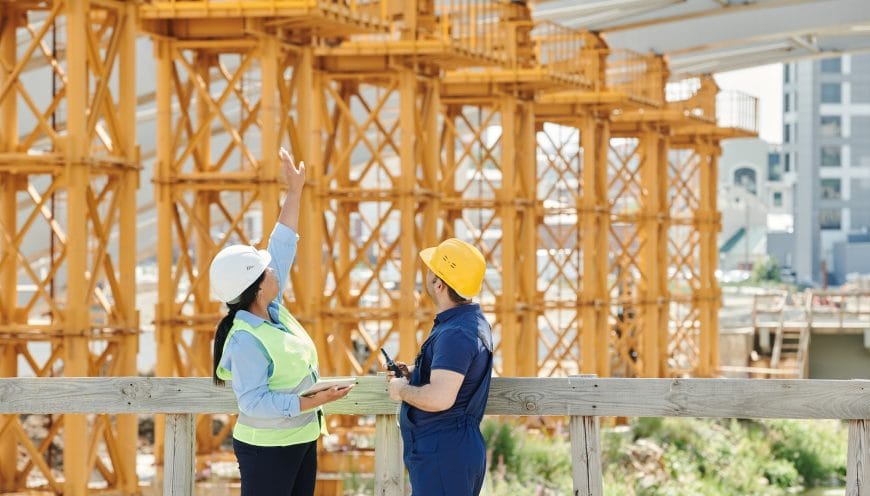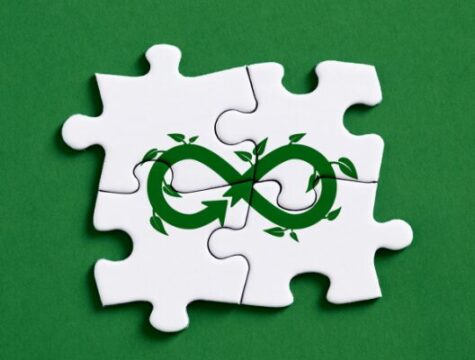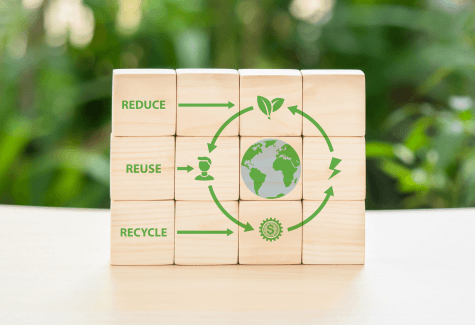von Alethya Cuberos und Daniela Raffo
Organizations like DGNB (Deutsche Gesellschaft für Nachhaltiges Bauen), LEVEL(s), und DIN-Normenausschuss Bauwesen (NABau) (Standards Committee for Building and Civil Engineering), play significant roles in promoting sustainability, setting standards in the construction industry, and also shaping and promoting responsible approaches within the construction and building sectors.
While the three entities contribute to promoting circular economy principles within the construction sector, they differ in their methodologies, scopes of influence, and the extent to which circular economy principles are integrated. Let’s see their approaches to sustainability and their role in pushing further Circular economy in construction.
Understanding the roles of DGNB, LEVEL(s), and DIN-NABau
To give a context for what each of these organizations does, we must first clarify their definition in order to differentiate between them.
DGNB, which stands for ‘Deutsche Gesellschaft für Nachhaltiges Bauen’ (in English the German Sustainable Building Council), is an independent non-profit association dedicated since 2007 to promote and certify sustainable and environmentally friendly building practices. LEVEL(s) on the other hand, is an initiative introduced in 2017, developed by the European Commission aiming to standardize and harmonize the way sustainability is assessed and measured in the construction sector across Europe, whereas DIN, is responsible for the development and maintenance of standards in the field of construction and civil engineering in Germany and it’s composed mainly of the industry sector (64%).
The 3 organisations work in different ways and use different mechanisms.
DGNB provides support to projects that want to move towards sustainability using as a mean a certification system, while LEVEL(s), doesn’t work as a certification scheme, it offers a common framework with indicators to evaluate the environmental performance of buildings using a free, open-source tool enabling building projects to assess, report and improve their sustainability performance. DIN, on the other hand, develops standards across various industries to ensure quality, safety, interoperability, and efficiency in products, services, and processes.
These organizations approach Circular Economy from different perspectives. As a certification system, DGNB’s scope and focus go into detail. It’s specifically designed to evaluate buildings based on sustainability criteria including those related to circular economy principles. It focuses on implementing and assessing sustainable practices throughout a building’s life cycle.
Conversely, LEVEL(s) as a harmonization tool, has broader indicators while providing a common language for stakeholders throughout Europe to follow. These common sets of indicators can therefore be adapted by various existing certification schemes or assessments.
In contrast, DIN develops technical standards across industries, including construction, which might encompass circular economy principles in a broader context.

Advantages of using one or the other
International recognition: DGNB certifications are highly respected and widely recognized internationally. They offer different certification levels, including platinum, gold, silver, and bronze, based on the level of sustainability achieved by a building project.
Flexible nature: LEVEL(s)’s main advantage is that the voluntary and flexible nature of the framework makes it possible to adapt and implement depending on the actors, project needs, or the phase during which they are needed. For instance, policymakers can use it to develop strategies and policies promoting sustainability in the construction industry across Europe. This promotes a more consistent approach to measuring and benchmarking sustainability performance. which means that Level(s) is a tool for putting local policies into practice.
Training and shared knowledge: DIN contributes to education and awareness not only by providing detailed courses to students at universities across Germany but also seminars aimed at informing stakeholders in the construction industry about the benefits and methodologies of circular economy practices in diverse areas of circular economy. DGNB also conducts research and provides education and training to professionals in the construction and real estate industries to promote sustainable practices and raise awareness.
Energy efficiency standards: DIN integrates sustainability and energy efficiency standards aimed at promoting renewable energy sources within energy-efficient buildings. However, DIN’s standards are voluntary but often widely adopted and referenced in contracts, regulations, and industry practices. The standards are reviewed every five years. If a standard no longer reflects the current state of technology, it is either revised or withdrawn.
Addressing Circular Economy
In crucial aspects of Circular Economy such as the lifecycle approach, both DGNB and LEVEL(s) consider life cycle assessment in evaluating sustainability, whereas DIN might contribute to specific aspects of sustainability within construction but is not exclusively focused on it.
Life cycle assessment is one of the criteria attributed to ecological quality in DGNB certification; while LEVEL(s) evaluates resource use and environmental performance, health, and economic aspects such as cost, value, and risks.
By assessing this entire life cycle, DGNB encourages the selection of materials, resource efficiency, and building practices that promote circularity, including using renewable resources, minimizing waste, and facilitating recycling or repurposing at the end of a building’s life. In addition, it ensures that all resources were obtained responsibly, therefore, certain labels and standards are requested. In the newest updates in 2023 the DGNB shared Criteria with special consideration of circular construction for New Construction. Another important tool published in 2023 DGNB Building Ressource Passport, which can be used for both new and existing buildings.
LEVEL(s) on the other hand, addresses the principles of the circular economy by incorporating 6 macro-objectives of policies at the EU and global level into 16 core indicators that promote circularity within the construction and building sector.
The indicators under these macro-objectives enable users to measure the environmental impact performance for issues of relevance for buildings – such as contribution to GWP, material flows and water consumption, as well as health and comfort aspects – based on a combination of existing EU standards, life cycle-based approaches, and circularity principles.
Interestingly, DGNB was involved in the testing phase of LEVEL(s) and has used it to align its own certification scheme with the framework.
Additionally, it is a good sign that the economic aspect of Circular Economy is included in LEVELS(s) indicators. It considers the life cycle cost and value of buildings, promoting economic assessments that account for the long-term value and benefits derived from adopting circular practices.
DIN develops and revises standards that encourage and facilitate circular economy principles in construction. This includes standards related to the use of recycled materials, assessment methodologies for circularity in construction products etc. Here is the example of the several norms, developed in 2023, considering the topic of circularity: Load-bearing earth block masonry – Construction, design and execution, Evaluation of the potential for sustainable refurbishment of buildings, Cement with recycled building materials. As the result of the published work of DIN Circular Economy, around 522 norms were identified relevant for the topic of construction and circularity (including DIN Spec).
How do Stakeholders apply them in practice?
The 3 organizations are used by architects and designers during the planning phase, also by
DGNB is mostly used by architects and designers who use its standards to comply with sustainable practices, but also by developers and building owners who seek certification to demonstrate sustainability of their projects aiming to attract tenants or buyers. Stakeholders should register the project, hire a DGNB auditor who supports the planning and construction process, and submit the documents for DGNB inspection and award certificate.
LEVEL(s) is an intersectional open-source software, free of charge, that can be used by architects, investors, designers, engineers, and construction companies. In practice, stakeholders need first to choose the building(s) to study, the level of performance assessment, and the indicators measured. Level(s) is delivered in the form of User Manuals and reporting templates that explain the concept, how to implement it, and how to record and measure the results. There are additional software companies that help to do the report.
Finally, to implement DIN a stakeholder needs to Identify the specific standards relevant to the construction project in aspects such as materials, structural design, safety protocols, electrical systems, etc. DIN offers an online catalog of over 450,000 documents some of which are available for direct download.

DGNB, LEVEL(s), and DIN significantly influence sustainability and standards in construction, each with distinctive roles and approaches to promoting circular economy principles.DGNB pushes forward Circular Economy by incorporating lifecycle assessments and offering the Circular Building toolbox which provides practical support for implementing circular strategies in construction projects. Level(s) put circularity into practice by including as a Macro-objective 2: Ensuring resource efficient and circular material lifecycles, which assess indicators such as Bill of quantities, materials and lifespans, Construction and demolition waste, Design for adaptability and renovation and Design for deconstruction. And, by establishing the Standardization Roadmap Circular Economy, DIN effectively promotes the transformation toward a Circular Economy and defines international framework conditions




